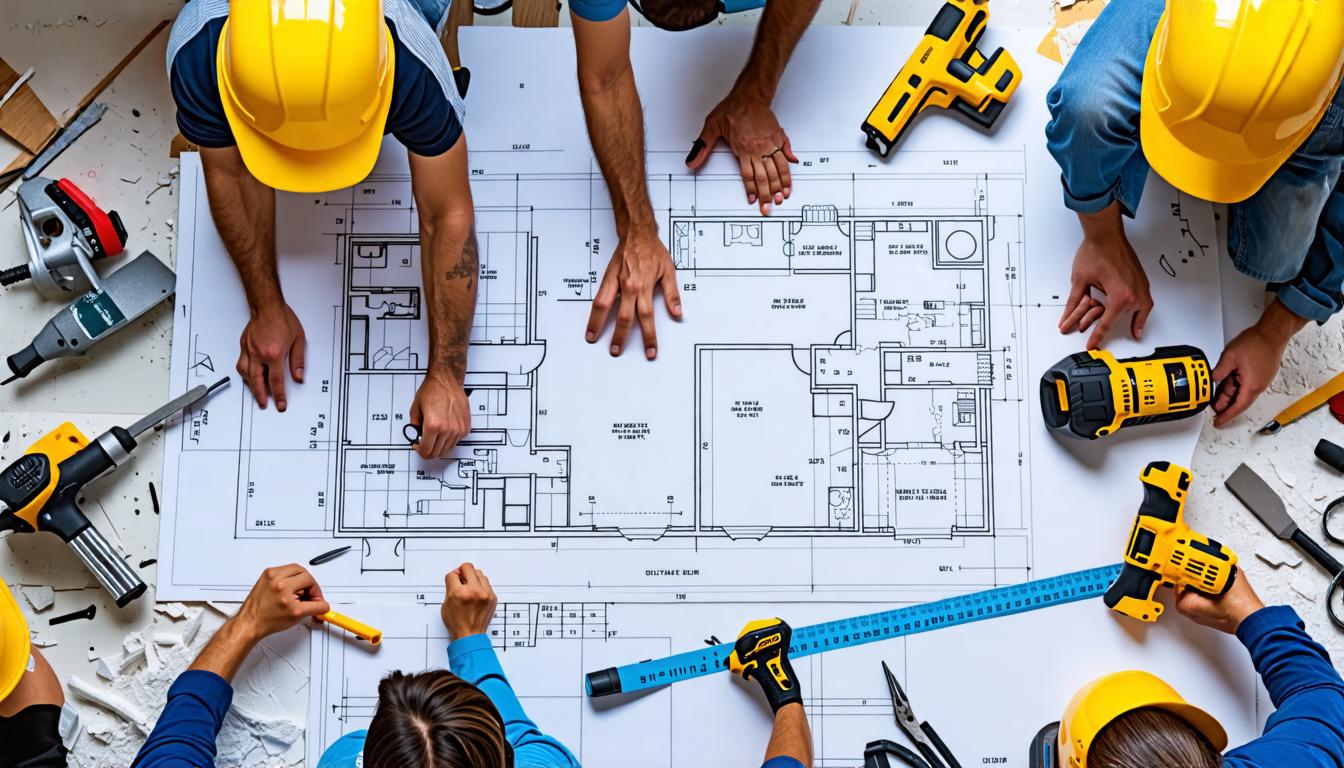Embarking on a home remodeling journey can be both exciting and daunting, as it holds the potential to transform your living space into the home of your dreams. Whether you’re looking to enhance functionality, update aesthetics, or boost your property value, a successful home remodeling project hinges on meticulous planning, informed decisions, and effective execution. In today’s fast-paced world, it’s crucial to stay ahead of trends and understand the critical factors that contribute to a seamless remodeling experience. This article delves into top tips for ensuring success, starting with the foundational step of planning — from defining clear goals and establishing a budget to selecting competent professionals who can bring your vision to life. We explore how to craft a feasible timeline to prevent logistical setbacks, ensuring your remodeling endeavor remains on track. Additional insights focus on design and material selections, emphasizing the importance of integrating contemporary styles and sustainable solutions to enhance your home’s appeal and efficiency. Finally, we address strategies for overcoming common remodeling challenges, such as maintaining open communication with your team and conducting thorough reviews to ensure satisfaction upon project completion. Dive into our comprehensive guide to discover how you can master the art of home remodeling, creating a space that’s not only beautiful and functional but also a true reflection of your personal style and needs.
Planning Your Remodeling Project: Essential Steps and Considerations
Define Your Goals and Budget: How to Set Clear Objectives for Your Remodeling to Avoid Overspending
When embarking on a home remodeling journey, it is crucial to start by clearly defining your goals and establishing a realistic budget. The success of your remodeling project largely depends on how well these foundational steps are addressed. Setting your remodeling objectives requires a thorough understanding of what you want to achieve—be it enhancing the aesthetic appeal, increasing the functionality, or boosting the overall value of your home.
Start by identifying the specific areas of your home that need remodeling. Consider what you hope to accomplish with each project segment. Are you looking to create an open-plan kitchen that becomes the heart of family gatherings? Or perhaps you want to modernize the bathroom to include spa-like features? By having a clear vision, you’ll be better positioned to steer your project in the right direction.
Linked closely to setting goals is establishing a comprehensive budget. Financial oversight is essential to prevent overspending and ensure your remodeling expenses align with your available resources. A common mistake homeowners make is setting a budget too low, which can lead to unexpected debt or project compromises. Begin by detailing every anticipated cost, including materials, labor, permits, and unforeseen expenses that often arise during remodeling.
To maintain control of your finances, consider adding a contingency fund—typically about 10-20% of the total budget. This financial buffer is vital when dealing with the unpredictable nature of remodeling tasks, such as discovering structural issues or needing to upgrade outdated wiring. By taking these proactive steps, you can manage expenses without sacrificing the quality or scope of your remodel.
Research and Choose the Right Professionals: Tips for Hiring Reliable Contractors and Designers
The importance of selecting the right team to bring your remodeling vision to life cannot be understated. Investing time in researching and choosing reliable contractors and designers can save you a considerable amount of stress and money down the line. Start by seeking recommendations from friends, family, or neighbors who have recently completed a successful remodeling project.
Conduct thorough background checks on potential contractors and designers. Verify their credentials and ensure they have the appropriate licenses and insurance to operate in your area. Don’t hesitate to ask for references and follow up with past clients to get a sense of their experience. Online reviews and testimonials can also provide valuable insights into a professional’s reliability and quality of work.
Once you have narrowed down your options, obtain detailed quotes from at least three different professionals. Be cautious of quotes that are substantially lower than others, as they might indicate lower quality materials or craftsmanship. Engage in open discussions with potential candidates about your project vision, timeline, and budget constraints to ensure they understand and align with your expectations.
Effective communication is key to maintaining a positive and productive relationship with your remodeling team. Establish clear lines of communication from the onset and agree on regular meetings or updates to discuss progress. By entrusting your remodeling project to the right professionals, you can alleviate much of the stress associated with major home renovations.
Create a Detailed Timeline: Strategies for Setting Realistic Deadlines and Managing Project Milestones
A well-structured timeline is essential in guiding your remodeling project from conception to completion. Setting realistic deadlines helps to streamline the process, ensuring each phase of remodeling is completed in an efficient and timely manner. Begin by outlining the major milestones, such as design approval, securing permits, or ordering materials, and break down these tasks into smaller, manageable steps.
Collaborate with your chosen professionals to establish a feasible timeline that accommodates both your needs and their availability. Factor in the duration required for obtaining necessary permits, sourcing materials, and coordinating with subcontractors, as these elements can significantly impact the overall schedule.
Anticipate potential delays by allowing flexibility within your timeline. Weather conditions, supply chain disruptions, or labor shortages can derail even the most meticulously planned projects. By building flexibility into your schedule, you mitigate stress caused by unexpected setbacks and maintain momentum towards project completion.
Employ project management tools to keep track of progress and deadlines. Digital platforms can help organize tasks, schedules, and communication, fostering better coordination among all parties involved. Regularly review and adjust your timeline as needed to accommodate any changes or improvements made along the way.
By planning your remodeling project with a keen eye for detail and effective organization, you lay a solid foundation for a successful renovation that reflects both your style and functional needs.

Design and Material Choices: Key Factors in Remodeling Success
Explore Trending Remodeling Designs: How to Incorporate Modern Styles Without Losing Functionality
Embarking on a home remodeling project offers the perfect opportunity to infuse your living spaces with contemporary aesthetics. To successfully blend modern design elements without compromising functionality, it’s crucial to stay updated with current trends. Start by researching popular design movements like minimalism, which emphasizes clean lines and open spaces, or explore the charm of mid-century modern elements that seamlessly combine retro and contemporary styles.
Lighting fixtures have become key focal points in modern remodels. Opt for statement pieces that offer a fusion of form and function, such as chandeliers with geometric designs or smart lighting systems that can be controlled with your phone. Moreover, open floor plans remain a popular choice, offering a sense of spaciousness and improved flow throughout the home. Thoughtful integration of these elements ensures a home that’s both stylish and practical.
Select Quality Materials: Guide to Choosing Durable and Aesthetic Options That Add Value
One of the cornerstones of a successful remodeling project is the selection of materials that not only enhance the visual appeal but also stand the test of time. When choosing materials, prioritize durability alongside aesthetics to ensure your investment pays off in the long term. Natural stone such as granite or quartz for countertops provides both resilience and luxury, while engineered wood flooring offers the beauty of hardwood with added durability and ease of maintenance.
For cabinetry, consider options like solid wood or high-quality plywood, which are known for their longevity. In areas prone to moisture, like kitchens and bathrooms, moisture-resistant materials such as porcelain or ceramic tiles are smart investments. On the exterior, fiber cement siding combines durability and a sleek appearance, protecting your home while enhancing its curb appeal. Choosing top-notch materials not only boosts functionality but also increases your home’s resale value, making it a practical choice for savvy homeowners.
Sustainability in Remodeling: The Benefits of Eco-Friendly Materials and Energy-Efficient Solutions
As environmental awareness grows, so does the appeal of sustainable remodeling practices. Incorporating eco-friendly materials and energy-efficient solutions into your home can significantly reduce environmental impact and lower utility bills. Consider sustainable materials like bamboo flooring, which is both renewable and robust, or reclaimed wood that adds character while minimizing the demand for new resources.
Energy efficiency is another essential consideration in modern remodeling projects. Integrating solar panels or utilizing energy-efficient appliances can drastically cut energy consumption, leading to cost savings over time. Installing high-performance windows with low-emissivity glass can improve insulation and reduce heating and cooling demands. Moreover, incorporating features such as green roofs or rainwater harvesting systems further enhances sustainability, ensuring your remodel is not only chic but also environmentally responsible.
In conclusion, making informed design and material choices is integral to ensuring the success of your remodeling project. By skillfully combining modern design trends with high-quality materials and sustainable practices, you can create a home that is as functional as it is beautiful.

When embarking on a remodeling project, overcoming challenges is crucial to ensuring a smooth and successful process. Even the most meticulously planned projects can encounter hurdles, making it essential to be prepared. Here, we explore strategies for anticipating common remodeling challenges, maintaining effective communication with your team, and conducting a thorough post-remodel review.
Anticipate Common Remodeling Hurdles: How to Prepare for Unexpected Delays and Budget Overruns
Remodeling, by its very nature, involves navigating a myriad of potential obstacles. One of the most common issues faced during a remodeling project is unexpected delays. These can stem from a variety of sources such as supply chain disruptions, unforeseen structural problems, or scheduling conflicts with contractors. To mitigate these challenges, establish a buffer within your original timeline. Setting aside extra time can accommodate such interruptions without significantly impacting your overall schedule.
Budget overruns are another prevalent challenge during remodeling projects. They often result from unforeseen expenses like the need to address hidden damages or the allure of upgrading materials. The key to avoiding budget overruns starts with a detailed budget plan, inclusive of a contingency fund—typically around 10-15% of the total cost. Regularly reviewing your finances throughout the project can help keep spending on track. Leveraging technology, such as financial tracking apps, can offer real-time insights into your expenditure, making it easier to adjust plans as needed.
Effective Communication: Best Practices for Maintaining Strong Collaboration with Your Remodeling Team
Communication is the linchpin of any successful remodeling project. Establishing a robust communication channel with your remodeling team can help avoid misunderstandings and keep everyone aligned with your vision and objectives. Begin by holding an initial meeting with your contractors and designers to discuss expectations, preferred communication methods, and project milestones.
Incorporating regular check-ins into the remodeling schedule promotes transparency and offers an opportunity for all parties to address concerns promptly. Utilize communication tools like project management software, which can streamline conversations and document progress. These platforms provide a centralized space to share updates, photos, and feedback, ensuring that everyone remains on the same page.
Moreover, clarity is crucial. Ensure that verbal and written instructions are clear and concise, leaving no room for misinterpretation. Encourage openness among team members so they feel comfortable voicing questions or concerns, which can prevent small issues from escalating into significant problems.
Post-Remodel Review: Steps to Ensure Quality Workmanship and Satisfaction Before Project Completion
Upon nearing the completion of your remodeling project, conducting a comprehensive post-remodel review is essential to ensure all work meets your standards and expectations. This critical step involves a detailed walkthrough of the remodeled areas with your contractors and project managers.
During this walkthrough, examine the work closely to identify any discrepancies or unfinished tasks. Pay attention to details such as the quality of finishes, the installation of fixtures, and the functionality of new installations. It’s often helpful to have the original design plans on hand during this review to verify that the work aligns with the initial vision.
If you identify any issues or concerns, communicate them to your contractors promptly, and establish a timeline for addressing these tasks. A reputable contractor will have no problem resolving outstanding issues, ensuring you are satisfied with the completed project.
Finally, consider documenting the outcomes of your review. Creating a project completion report may serve as a valuable reference for future work, or if you encounter faults that may require warranty claims down the line.
By proactively recognizing potential challenges, fostering effective communication, and ensuring a thorough post-project review, you set the foundation for a successful and satisfying remodeling process. Emphasizing these elements not only enhances the quality of work but also contributes to a positive experience, reinforcing the value and enjoyment of your newly remodeled space.
Embarking on a home remodeling project can be both exhilarating and daunting. By carefully following the essential steps and considerations outlined in the article, homeowners can lay a solid foundation for a successful transformation of their spaces. It all begins with defining clear goals and establishing a realistic budget to prevent overspending. This initial planning stage is crucial for maintaining control over the project’s direction and ensuring that financial constraints are adhered to throughout the process.
Equally important is the selection of the right professionals. Thorough research and careful vetting help in engaging reliable contractors and designers, whose expertise can greatly influence the outcome. Coupled with this is the need for a detailed timeline that sets realistic deadlines, helping manage expectations and project milestones effectively. This strategic organization paves the way for smoother progression through each phase of the remodel.
Design and material choices are pivotal in achieving both aesthetic appeal and functional success. By exploring modern design trends, homeowners can create spaces that are both contemporary and practical. The insistence on high-quality materials further enhances the remodel’s long-term value, ensuring beauty and durability that withstands the test of time. Additionally, embracing sustainability through eco-friendly materials and energy-efficient solutions not only benefits the environment but can also result in cost savings and increased home value, making it a wise investment.
The path to a successful remodeling endeavor is not without its challenges. Anticipating common hurdles, such as unexpected delays and budget overruns, equips homeowners to tackle them with minimal disruption. Maintaining open, effective communication with the remodeling team fosters a collaborative atmosphere, ensuring that all parties are aligned towards the shared vision. Finally, a thorough post-remodel review, focusing on quality workmanship and overall satisfaction, guarantees that each element of the project meets the highest standards before completion.
In conclusion, while a remodeling project can be complex and challenging, careful planning, informed decision-making, and proactive problem-solving can lead to highly rewarding results. By following the top tips outlined in this article, homeowners can navigate the remodeling process with confidence and achieve the home transformation of their dreams.

